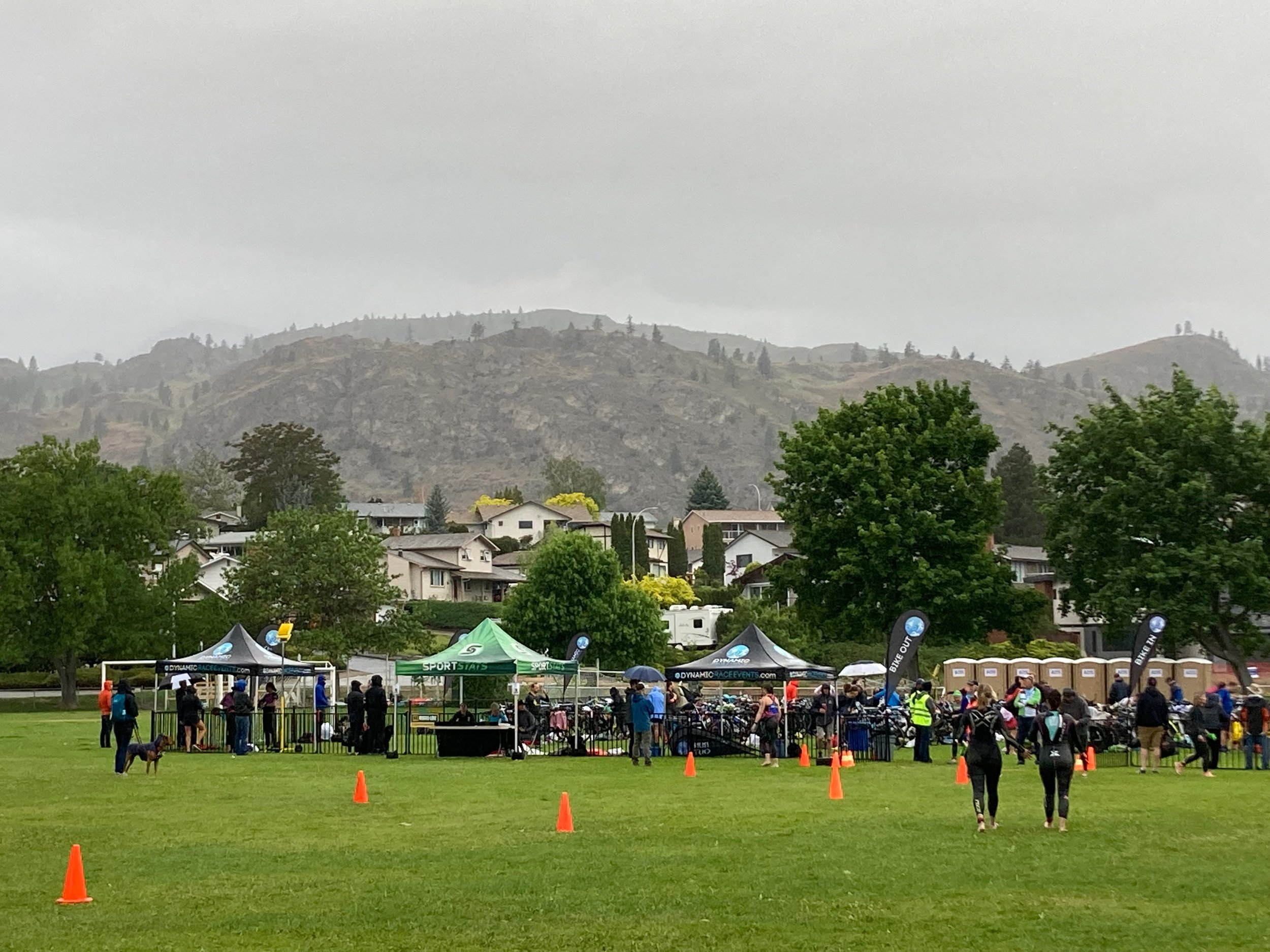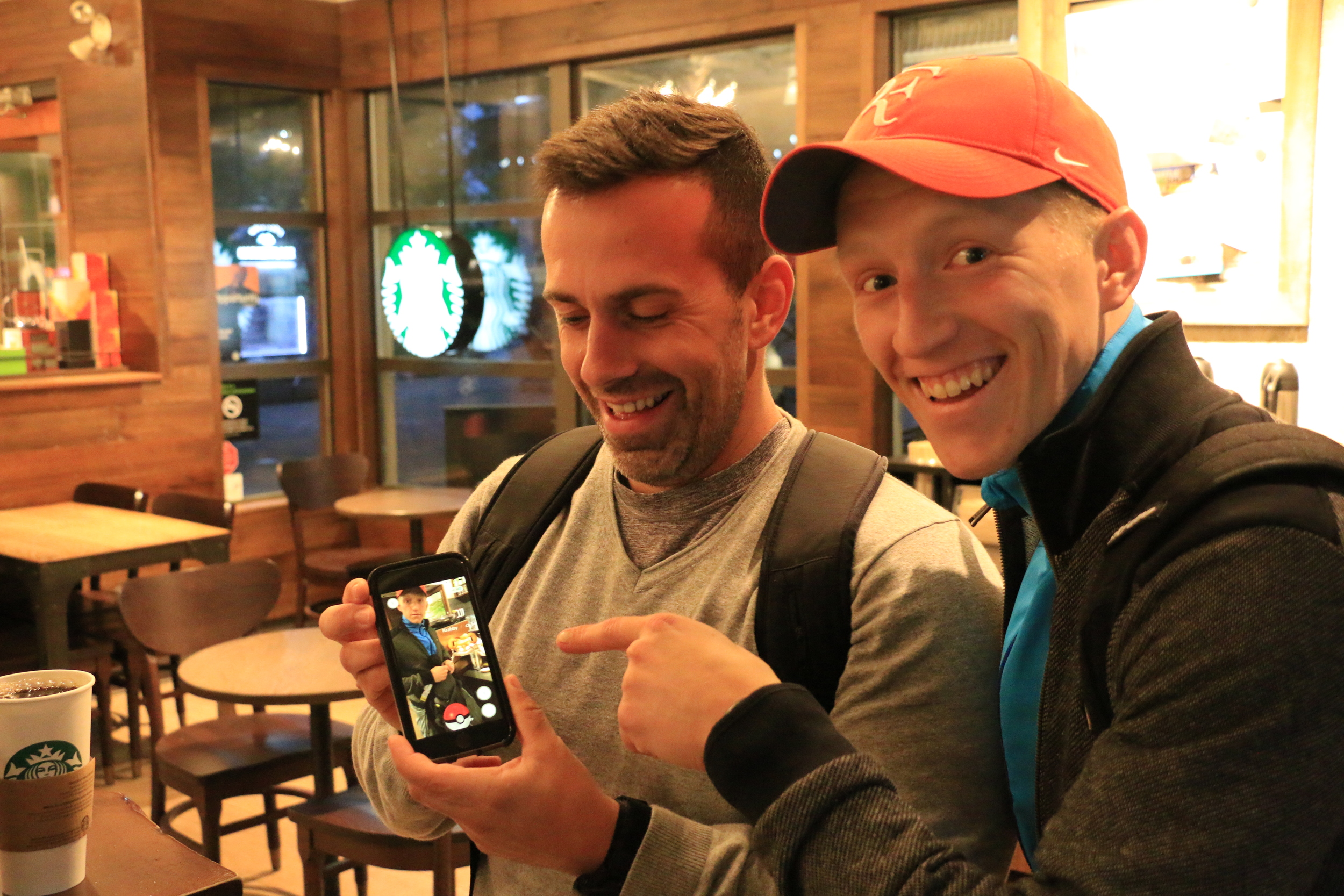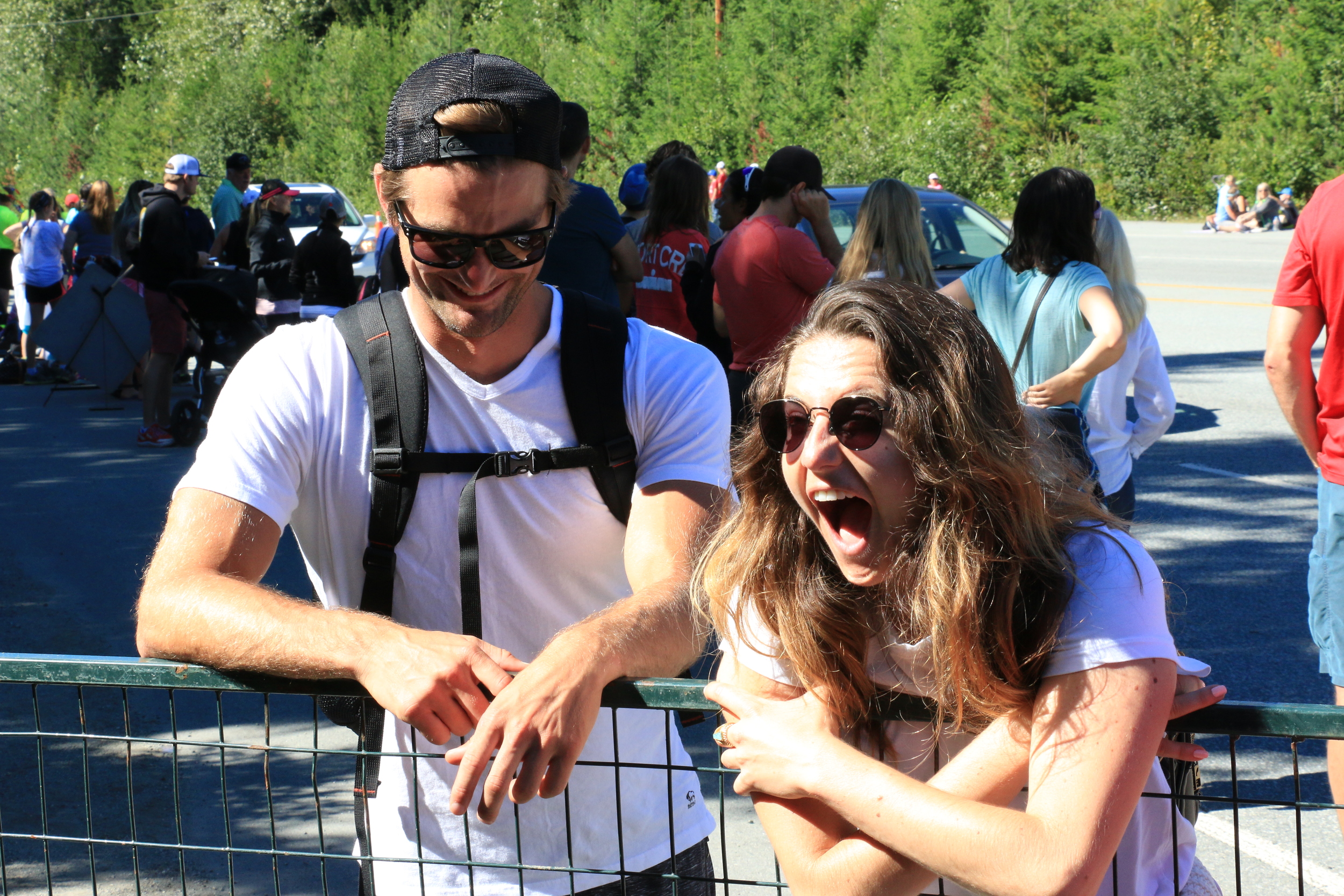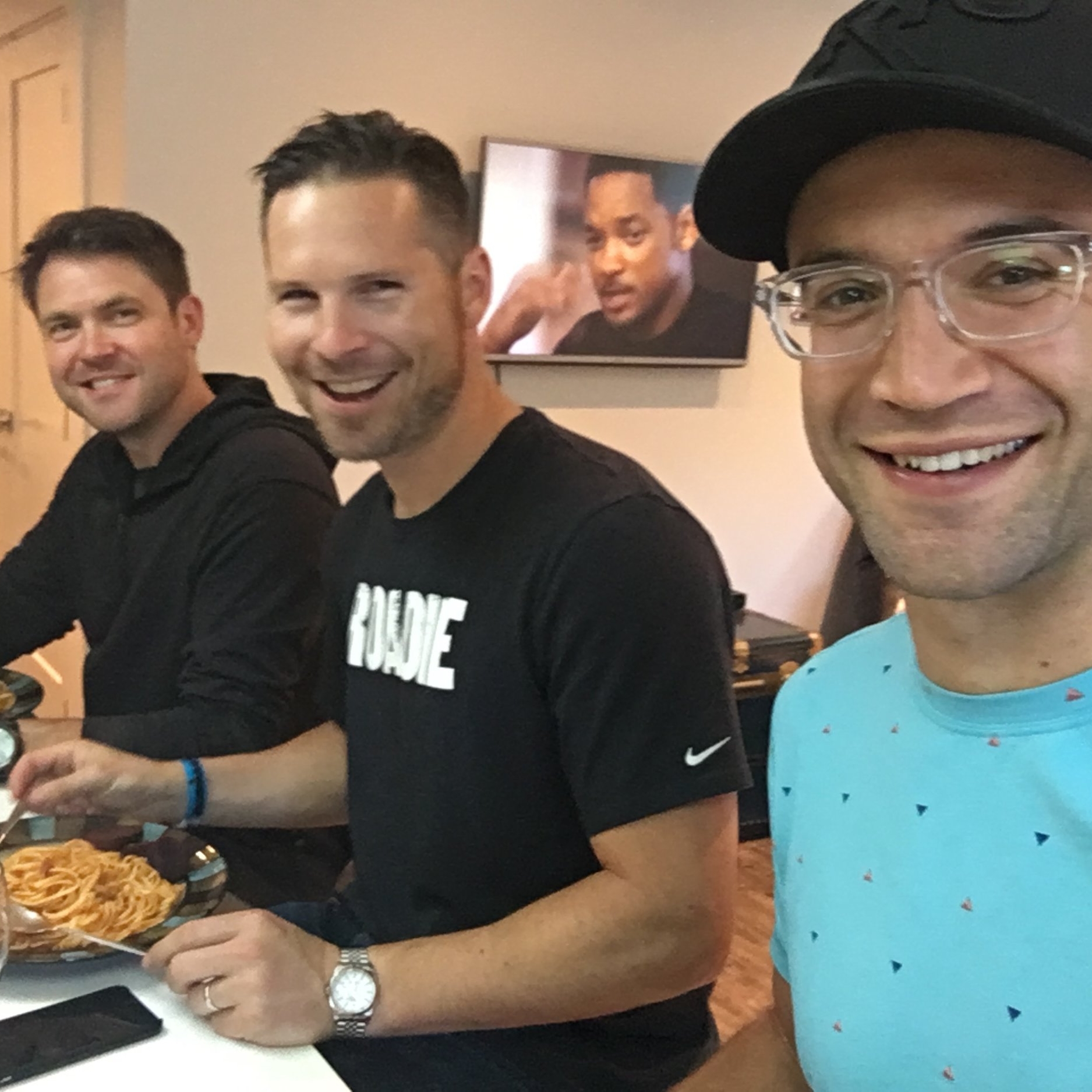That finish line feeling!
TL;DR
Solid first Ironman in the books! The ‘good’ goal was to finish in under 12 hours, ‘great’ was to finish in under 11, and the golden number was 10h 47m. The swim went better than expected, and the bike went as planned – coming out of T2, things were looking fantastic and I was just one minute down on the schedule for the day(!). After 10k into the run, my stomach turned upside down (GI issues) and let’s just say there were a few unscheduled pit stops. Had stomach cramps for about a third of the run and had to walk a lot, which cost time. My right knee started becoming an issue on the bike (made two stops to stretch) and then after about 10k into the run, it needed frequent stretching along the way. Rallied to finish in 11:57. Proud of the day; got gritty when it counted, and definitely enjoyed that run over the red carpet!
It was also pretty special to be a part of the return of Ironman to Penticton, arguably this event’s spiritual home in Canada (“The Legend Returns”). The City of Penticton hosted the event for almost 30 years from 1983 to 2012, then it went to Whistler for a few incredible years, and now it’s back. Penticton did not disappoint.
The journey to this point
Context is everything: I first set the goal of completing an Ironman back in 2013, at the very beginning of my exploration into endurance sports. At that time, I was perfectly naïve about the amount of time and money, and physical, mental and emotional energy, that would be required to not only get to the start line – but also, to get to the finish line of an Ironman. I set the goal in 2013 and fully expected I’d figure out how to line up in 2014 - ha! I mean, it wasn’t all crazy: I did do my first Olympic and half-Ironman triathlons that year, and so began what’s been almost a decade of learning alllll the things there are to learn about long course triathlon.
But along the way, life happens, bringing with it shifts along all the usual dimensions: career, finances, relationships, injuries, interests and so on. There were speed bumps: 2016 was my first attempt at Ironman, where I learned the lesson that there’s no such thing as over training, only under recovery. A year later, in 2017, I hit the deck hard on a gravel ride and ended up needing emergency fasciotomy surgery on my right arm. 2018 brought a career shift and three intense years at a tech company called Clio. 2020 brought us COVID-19. 2021 brought a dream job at a dream company: Jane App, another high growth story whose mission and values align so well with my own. And finally, the stars started aligning on the life circumstances needed to take another run at this big-ass goal in 2022. On November 11, 2021, I registered for Ironman Canada and the next chapter of the journey began.
If there’s something that’s driven me for most of my adult life, it’s the belief that you’ve got to do the epic shit in life that’s worth getting fired up for. We don’t get emotional deadlines very often: when you have to work so hard for so long and then put it all on the line when the opportunity presents itself and give so completely of yourself just to see how you measure up. Most people avoid these deadlines. Some seek them. I’ve been chasing this one for nine years. It meant a lot. Here’s how race weekend played out!
Race morning
A great race morning starts with where you book your accommodation, because that makes all the subsequent logistics easier or harder. I lucked out and found a place that was a 10 minute walk from the transition area. That made everything else on race day easier, for both me and my crew. With the swim scheduled to start between 6:30 and 7am, and Transition opening at 5am, I got up at 4am, had my usual breakfast, and stretched and rolled out. Body was feeling good. With bottles filled and gear packed, we headed out the door and walked over to Transition, and dropped off the special needs bags on the way. In my special needs bags: Bike bag included a spare pair of contact lenses, a Ziploc bag with four scoops of EFS (enough to mix 1.5L of hydration), and a spare tube. Run bag included another spare pair of contact lenses, and a Ziploc bag of peanut M&Ms that I never imagined I’d need, but that turned out to be rather helpful later on (thanks to my adventure buddy and two-time Ironman Tom for the suggestion).
Race kit: locked and loaded!
I got into Transition not long after 5am and it wasn’t too busy, which is just the way I like it (calm energy). A training pal and four-time Ironman, Ryan, told me to bring a headlamp which was a great suggestion that I didn’t follow (worse, I brought one on the trip, but decided to leave it at the house). Yes, the morning light is starting to come up, but it’s nowhere near enough to see properly and as soon as I found my bike, I wished I’d brought that headlamp! Lesson learned. I got the hydration system on the Shiv filled up, set my take-off gear, checked the tyre pressures, laid out my stuff, took one last mental picture of where my bike was in transition, and headed back to the house.
Now this may be TMI, but being able to take your pre-race #2 and then put on your wetsuit in the comfort of your own space? Luxurious. Never had that situation before, and future race logistics shall be planned accordingly, LOL. With time to spare, I checked I had everything one last time, and we walked over to the swim start.
Swim
For the first time ever I was actually looking forward to the swim. I’d done more preparation than I’d ever done before. Having never been a strong swimmer, it’s the thing I tend to avoid. This time around, I started swimming 15 weeks out from race day, both in open water and in the pool (with a fairly even mix between the two). Experienced folks reading this will probably think that’s nowhere near enough but for me it represents progress and at a minimum that’s what I care about: being better than last time. Things that really helped with getting in the water:
Open air pools, ‘cos who wants to be cooped up inside when spring and summer are here.
An open water swim pal, because it’s comforting knowing that someone’s around in case you have a freak out and need a pal to remind you you’re fine. Ben Owens, you’re a saint!
A Swim Buddy buoy for open water so you’re visible, and are able to take a break whenever you need it.
A wetsuit that fits. Turns out, I’d been a wearing a wetsuit that was one size too small for eight years, ha!
Last and probably most important: just that strong desire to show up to your big race knowing that you overcame your fears, discomfort, and personal bullsh*t so that you could give it your best shot when it counted.
So with quiet excitement I walked down to the beach and did a short warm-up – which is another thing I don’t tend to do. Enough open water swims in training have taught me that the first few minutes of my swims always tend to feel a bit tense: the cold water is seeping into your wetsuit, your muscles are warming up, you need to find a rhythm. It takes a little while to get comfortable, but on race day, you can get that tense part out of the way by making use of the warm-up time, and it really helped me on this occasion.
The start was self-seeded and I put myself in the 1:10-1:20 group. I’d budgeted 1:22 for my swim but felt confident I’d come in under 1:20. They let us into the water six athletes at a time, every five seconds. The sun was just coming up over the hills, the sky was blue, and it was a beautiful day for a race. One minute there were ~1,500 of us all lined up in our wetties, the next minute, the pros were off! A bit more shuffling along and it was time for the age groupers to get going. And just like that, the timer beeped, the gate dropped, and the day had begun.
Those first few hundred metres felt more tense than I’d have hoped: lots of people around, zig-zagging, bumping into each other; it was hard finding some clear water. I don’t yet thrive in the melee that is a triathlon start (but I’m looking forward to figuring out how I can). I found myself switching to breaststroke which is exactly not what I wanted to be doing because it’s slower. That said, you do what you need to do and it was too early in the day to be getting flustered: so I kept up the positive self-talk, kept moving, eventually found some clear water, and got the freestyle going.
By the time we got to the first turn buoy, the sun had crested the hills to the east and I was now copping an eyeful of it every time I turned to breathe (even with tinted goggles). I’m definitely better at breathing to the right than the left – my stroke is more efficient, and I swim straighter – and while I tried breathing to the other side, it just wasn’t working. That said, the sun was only bad for a few hundred metres as we were now rounding the top of the loop and I was getting in my groove.
By the time we hit the turn buoy for the way home, I’d really found a rhythm: I felt calmer and in control, like I knew I was going to make it (!) and it actually felt good. So good!! I took a minute to just soak up the feeling of enjoying the swim – still a novelty for me. I’d be back at the beach before I knew it, and this was going to be a long day.
I hit the beach, ran over the timing mat and looked at my watch: 1:15! Seven minutes ahead of schedule, and I’d swum >90% freestyle, so the day was off to a great start. Heck yeah!
T1
Swim to bike transition went pretty much to plan, although things took a little longer than expected. I’d budgeted 3:00 minutes and took 4:59, but wasn’t bothered about that as I wanted to make sure I did everything I needed to do before heading out for the longest leg of the race.
Bike
Heading out on the bike I noticed my body and mind felt tense – I wasn’t as relaxed through the swim as I’d like to have been overall, so I made a mental note: keep working on that swim. I dreeeam of being able to get out of the water feeling refreshed and relaxed after a strong swim. The physical tension manifested mostly in my neck and upper back. The mental tension came from the overall experience of the swim: even though I’ve improved, it still rattles me a bit and it takes a little while to settle down after. That said: it was early in the day and having bookmarked those thoughts and feelings for the post-race reflection, I set about getting on with it. I was on my rocket-Shiv and sailing down the eastern shores of Skaha Lake and hot damn did it feel good. I LOVE THE BIKE!
Rolling down the eastern shore of Skaha Lake
My nutrition strategy for the bike was primarily liquid and hinged around EFS, a product that fulfills my caloric and salt needs all in one. I’d need to consume 6x large (~750mL) bottles of the stuff over 180km, and I also hoped to get 5x Skratch rice cakes down. The Shiv has a 1.5L hydration system so I carried a bottle of concentrate and employed a two-stop strategy where I pulled in at aid stations and used water + concentrate to refill the hydration system. Stop 1 was the Richter Pass aid station (70km mark; 2h 4m into the ride) and Stop 2 was at the top of the climb at Yellow Lake (123km mark; 3h 44m into the ride). Both stops went quickly and as expected.
I struggled to get the rice cakes down and that may have contributed to issues that came up later on in the day from not having ingested any solid food. I found it challenging fumbling with wrappers (perhaps I should have pre-opened them) and just holding the food while riding on open roads with lots of up and down. The course was hilly: if you weren’t climbing, you were descending. I got one rice cake down and that was that – in hindsight, I should have tried to get at least another one or two down.
Elevation profile of the Ironman Canada bike course. Total gain = ~1,900m / ~6,200 feet
Mentally, I’d broken the bike course down into a series of segments so that it was easier to chip away at. I set auto-lap alerts on my Garmin for every 5km and time alerts for every 30mins. These helped create a sense of momentum (you’re hearing a beep of encouragement at least once every 10mins), provided reminders (are you fuelling?), and generally provided positive reinforcement.
After the first two hours on the bike I noticed tension building in my left QL (quadratus lumborum), and right knee. The right knee got to the point where I had to get off and stretch (otherwise, it hurt to put power through it). That was about 75% of the way up the Keremeos climb (127km mark; 4h 2m into the ride). Stretching provided some immediate relief and I was able to put down the power until I needed to stop again and do the same stretches (primarily quads, but should have done glutes too) at the turnaround of the out and back section (148km mark; 4h 37m into the ride).
From that point on, it was head down for the final hour to get back into Penticton. I rode steadily and made sure I got down as much nutrition as I could, and by the time I got into transition: I was reeeally happy to get off the bike!
I learned post-race that having exited the water in 542nd overall out of 1,585 athletes, I made up 436 places on the bike and came into T2 in 106th overall. Pretty stoked about that. I’d budgeted 5:27:16 for the bike and it took me 5:34:56. Coming into the bike leg I was 5 minutes ahead of schedule, so I’m now 3 minutes behind schedule – sa-weet.
180km bike, done!
T2
I’d allowed 10:00 minutes so that I could have plenty of time to do a proper stretch as I knew I’d likely be tight coming off the bike and that taking that time would set me up well for the run. That stretch felt gooood: glutes, hams, hip flexors, quads, and calves all got some love. I’d packed a hand towel so that I could wipe the grime off my face, legs and arms and freshen up a bit – small comforts can and do help in an event like this. I took down a Maurten gel (non-caf), grabbed some sunscreen for my neck, hit a portaloo to take a leak, and headed out on the run.
Time in T2: 7:57. I’m now just 1 minute behind schedule on the day’s plan for a 10h 47m Ironman. Rad!
Now, it’s worth noting that I wasn’t attached to the 10h 47m number – because if the wheels fall off you have to be able to let go of that and figure out how to adapt whilst keeping a positive mindset. That number was meaningful because it gave me something to fight for. ‘Doing your best’ is great as a general rule but won’t motivate you enough in the final hours of an Ironman to really lift when you need to. Having those three time goals (good: break 12h; great: break 11h; awesome: hit 10h 47m) gave me numbers to fight for in a variety of situations and ultimately, gave me the reason I needed to really dig deep in the final hour of this race.
These were my Ironman time projections. Pretty pumped about how close plan was to forecast up until the run.
Run
I read a course preview by a tri coach from Kelowna who said that ‘likely the smartest thing you will do on race day is walk the Vancouver hill’ and – having recon’d this section a few weeks prior to race day to validate this piece of advice, I indeed walked that hill and believe it served me in good stead. That thing is steep!
Mentally, I had broken the run course down into five out and back sections:
The 10k out and back along the KVR trail.
First 10k out and back down Main Street.
First 6k out and back along Lakeshore Drive.
Second 10k out and back down Main Street.
Second 6k out and back along Lakeshore Drive.
Each of those out and backs is obviously two mini-sections, so in total, I had 10 segments to focus on, and that’s how I broke down a 42.2km marathon-at-the-end-of-an-Ironman problem into 10 much more mentally manageable things to tackle one-by-one.
Once I got up onto the KVR trail I found myself hitting 5:25 / km pacing and it felt entirely doable. My body felt good, heart rate was in a great place, and while I knew there was a lot yet to do, I could see the path to get there. But when I got to the turnaround on the KVR, I had my first feelings of an unsettled gut. Without going into too much detail, I contemplated using a portaloo there, but decided to go another 5k and see how I felt when coming back through the transition area…
Yup, had to go. These kinds of pit stops *suck*. Wriggling out of a one piece tri suit when you’re hot, sweaty, and covered in salt isn’t my idea of a good time. And it all eats the clock. But with that taken care of, I thought it would be smooth sailing from that point on.
Not quite. At the first turnaround at the bottom of Main Street, some pretty gnarly cramps started setting in, and I also realized that my unsettled guts might not be done with their theatrics for the day. I walk-jogged to the 20km mark and made another time-consuming pit stop. The cramps in my gut had gotten pretty bad and I was walking hunched over. Coming back through town was pretty humbling. I saw my crew, told them what was happening, and to expect a slow day from that point.
This was coming out of T2 – still happy days at this point, ha!
It was rough going between about kilometres 16 to 29 – lotsa walking, a little bit of jogging, and frequent stops to stretch (right knee was tight). I tried taking in some solid food: a handful of chips here, a few pretzels there, some peanut M&Ms (I’d picked up my special needs bag). I always kept a cup of ice with me, holding ice cubes in one hand and occasionally putting smaller bits of ice down my tri suit or under my cap, to manage temperature (it was hot, but not crazy hot).
At the second turnaround at the bottom of Main Street, I looked at my time on the day overall and calculated that – if I could start jogging again – I could potentially still come in under 12 hours. I had to fight! It was now about doing whatever it took to make the ‘good’ goal. By the time I got back to town, I was still gritting my teeth, but the cramps had eased up, I was finding my stride and I only had the last 6km out and back section to do. I was determined to come in under 12!
That last 6k was tough, and the run overall was pretty brutal, but there was never any doubt in my mind that a) I was going to finish and b) this is 100% worth it and in no way diminished by the slowness due to the gut issues.
In the end, I ran down the red carpet and stopped the clock at 11:56:58. I’d made the ‘good’ goal and heard those sweet, sweet words: “You are an Ironman!!”.
I got my finisher medal, walked over to the fence, and totally bawled for a minute. It was a release that was less about the events of that particular day and more about the journey of the last nine years since setting the goal – I’d finally done it. All those ups and downs, setbacks, learnings and moments of progress along the way that made this act on this day possible. I’ll never take a start line for granted and completing this event was so deeply satisfying – in time I’ll find more eloquent ways to describe it.
Post-race reflections
Some very immediate thoughts came to mind in the day or two following Ironman:
I was super proud of my mental game throughout the day. I stayed checked-in for twelve hours straight, and when things started going off the rails, I stayed positive and kept adapting, doing whatever I could to make forward progress. I never gave up, not even for a second. Real proud of that grit. Takes you a long way in racing, and in life.
I do these things to explore my physical potential, and I seek to fulfill my potential in everything I do.
I had the fitness for a sub-11 hour Ironman on the day, but wasn’t able to execute that primarily due to the gut issues.
I have two key areas of improvement: First, figuring out what nutrition I need to get through an Ironman with happy guts. Second, resolving whatever issues are present in my body that are causing the tightness in my lower left back and right knee.
My desire is to race to my potential: and given the above, I can’t wait to do another one!
Thank-you
As the saying goes, it takes a village to make something like this happen. Here’s a huge shoutout to my race crew, and all the training buddies, athlete friends, helpers, bodyworkers, and race mates I’ve shared the journey with over the years – you know who you are. I’m forever grateful!
And a massive thank-you to the small army of volunteers who lent their time in Penticton to help make this event a success – I was constantly wowed by your generosity and willingness to help. Kudos!






















































































